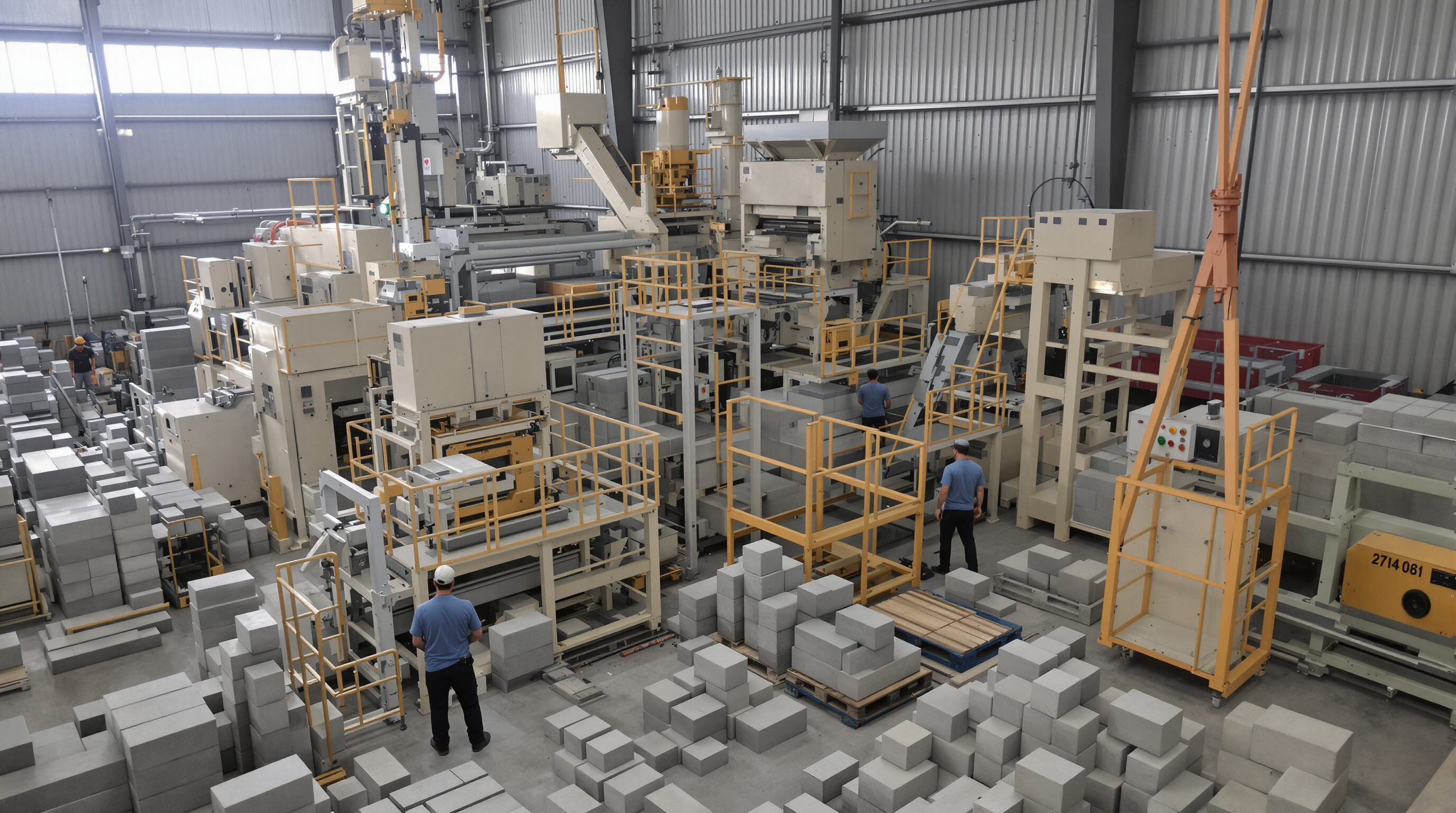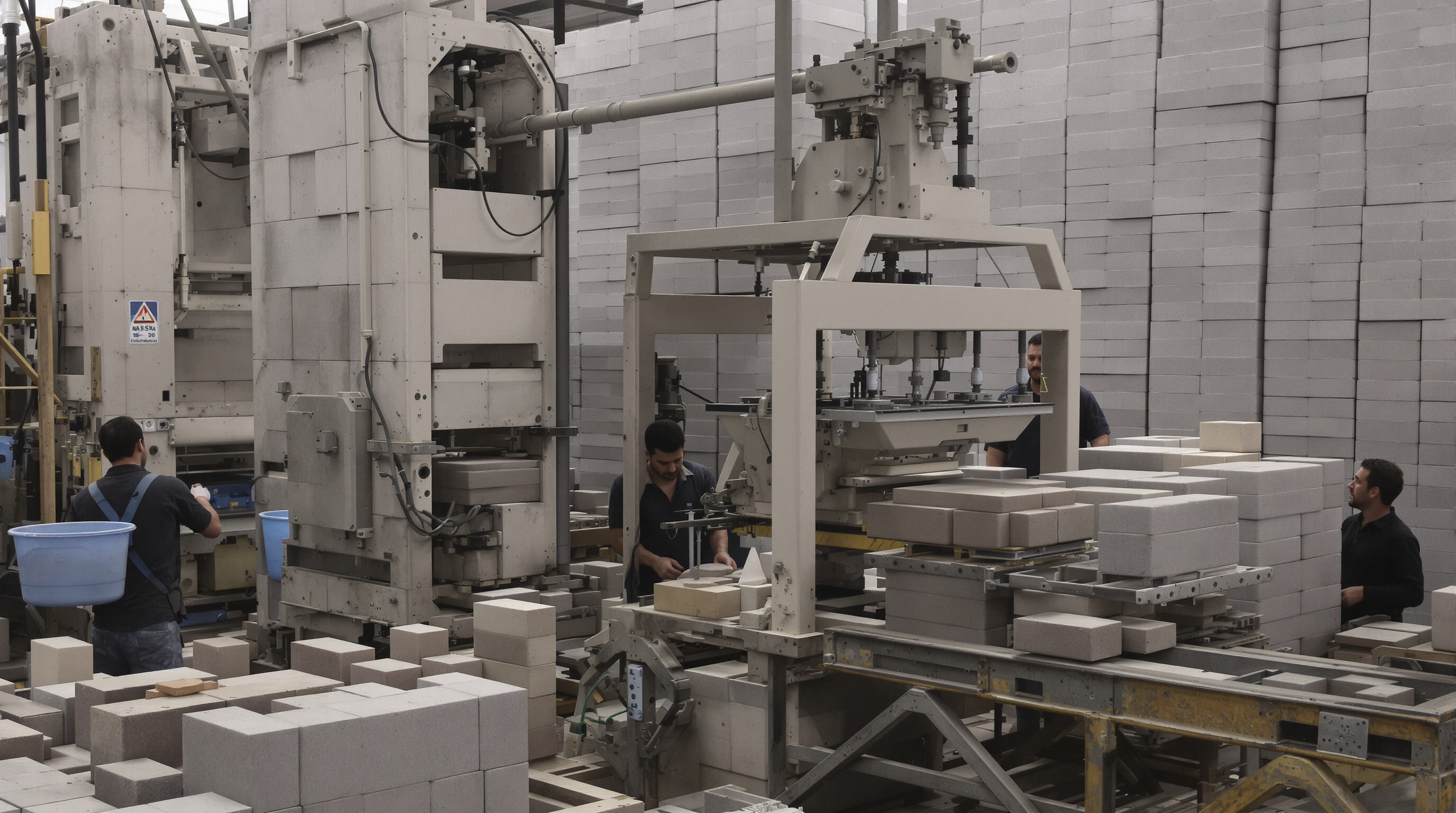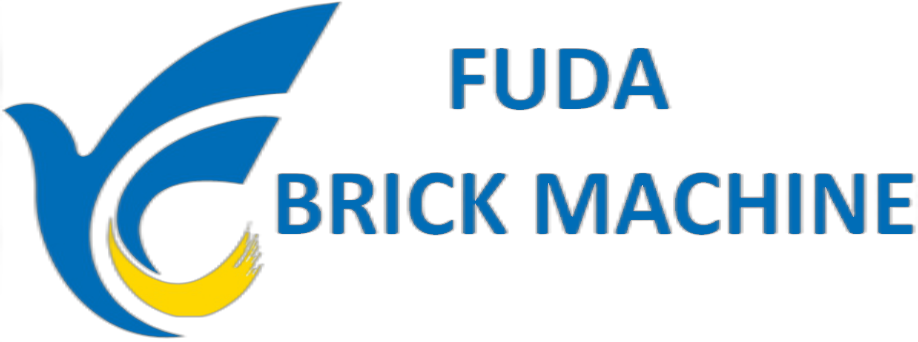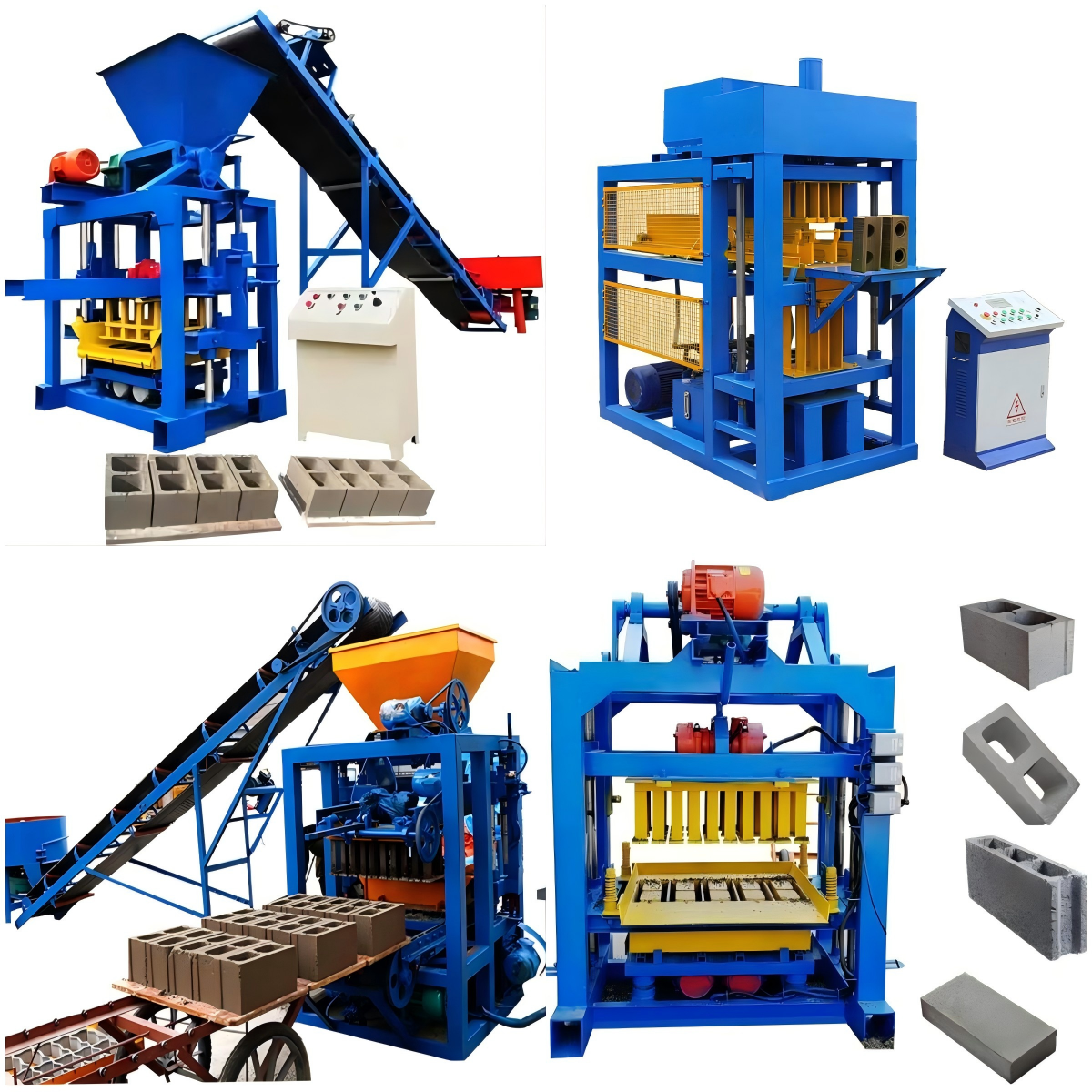מהי מכונת עשיית בלוקים חצי אוטומטית ולמה היא חשובה ב בנייה מודרנית
הגדרה ותפקודים עיקריים של מכונות עשיית בלוקים חצי אוטומטיות
יצרני בלוקים חצי אוטומטיים משלבים פיקוח אנושי עם רמת אוטומציה מסוימת ביצור בלוקים בטון, לבנים, וthose אבני הריצוף שאנו רואים בכל מקום. העובדים עצמם אחראים לטעינה של הרכיבים הבסיסיים כמו צמנט, תערובת חול, ואגרגטים לתוך המערכת. בשלב הבא מגיע החלק הכבד יותר שבו הלחץ ההידראולי מבצע את רוב העבודה יחד עם תבניות שמבוקרות על ידי מחשב אשר שומרות על אחידות במראה של הבלוקים. רוב הדגמים מסוגלים לייצר בין 800 ועד אולי 1500 יחידות במשמרת עבודה בת 8 שעות, שזה בערך מהיר פי ארבע עד שש פעמים בהשוואה לייצור ידני לחלוטין. זה הופך את המכונות הללו לאפשרויות די טובות לפרויקטים ביניים בבנייה, שבהם יש צורך ביצור נפח גדול, אך עדיין אין רצון להוציא הרבה כסף על ציוד אוטומטי לחלוטין.
התפקיד בשרשרת שבין עבודה 손אית לבין אוטומציה מלאה
המכונות לייצור בלוקים חצי אוטומטיות באמת פותרות את הבעיות עם שיטות ישנות שבהן אנשים נאלצים לעבוד קשה כדי לייצר רק 200 ועד אולי 300 בלוקים ביום. כשמכונות אלו מבצעות את תהליכי הדחיסה והעיצוב בעצמן, הן מקלות משמעותית על העובדים פיזית, ובעיקר מאפשרות להשיג יותר תפוקה בסך הכל. ויש פה גם היבט מעניין שמח يتعلق במחיר – המכונות האלו למעשה עולות anywhere בין 35% ועד כמעט מחצית ממה שמכונה אוטומטית לחלוטין תעלה. עבור חברות הממוקדות באזורים שבהם המשאבים מוגבלים יותר, הגישה האמצעית הזו הגיונית, שכן היא מביאה רמת מיכון מסוימת, מבלי להכניס את המשתמש לתוך הכאוס של ציוד יקר שדורש חשמל מתמיד ותיקונים מורכבים. אז בפועל, זה נותן להם מסלול מציאותי להתקדמות לעבר מודרניזציה, מבלי לשבור את ngân או להעמיס על התשתית הקיימת.
הביקוש לפתרונות בנייה מוצלחים במדינות מתפתחות גדל
הגידול המהיר של הערים ברחבי אפריקה שמדרום לסהרה וחלקים מדרום מזרח אסיה גרם לדחיפות אמיתית לאמצעי בנייה זולים. לדוגמה, ניתן לציין מכונות לייצור בלוקים באופן סמי-אוטומטי. תושבים מקומיים יכולים לייצר בלוקים בגדלים סטנדרטיים במחירים של כ-12 עד 18 סנט לא piece, מה שמייקר אותם ב-45% פחות בהשוואה לבלוקים המשווקים ממדינות אחרות. מגוון רחב של גורמי ממשלה וארגונים ללא מטרת רווח החלו לשלב את המכונות הללו בתוכניות הדיור שלהם, תוך עידוד ייצור מקומות עבודה וקידום פרויקטים תשתיתיים בפועל. בשנה שעברה נמכרו כ-12,000 מכונות כאלו במדינות כמו הודו וניגריה, מה שמראה עד כמה הן הפכו להיות חשובות להרחבה עירונית בדרך ידידותית לסביבה.
יעילות כלכלית: איזון בין ההשקעה, עלויות תפעול, ותשואה על ההשקעה (ROI)

ההשקעה הראשונית בהשוואה למערכות ידניות ומערכות אוטומטיות לחלוטין
מכונות לייצור בלוקים חצי אוטומטיות מציעות נקודת כניסה מאוזנת, עם מחירים בטווח של 8,000–25,000 דולר (דוח מכשורי הבנייה העולמי 2023). מיקום זה ממקם אותן בין התקנות הידניות הבסיסיות, שמחירן 1,000–5,000 דולר, לבין מערכות אוטומטיות לחלוטין שעולות על 100,000 דולר. למערכות צומחות, ההשקעה בקטגוריה הזו תומכת באוטומציה מדורגת תוך הפחתת הסיכון הכספי.
חיסכון בעלויות הפעלה באמצעות אוטומציה חלקית
כאשר חברות מטמעות אוטומציה חלקית, הן בדרך כלל תראו ירידה של 40 עד 60 אחוזים בדרישות כוח העבודה בהשוואה לשיטות ידניות מסורתיות. במקביל, מערכות אלו צורכות פחות או פחות שני שליש מהכוח שמערכות אוטומטיות לחלוטין צורכות. מנהליי מפעלים רבים מציינים חיסכון של somewhere מ-15,000 עד 35,000 דולר בשנה الواحدת על ידי עלויות תפעול מופחתות וניהול טוב יותר של חומרים. דגמים חדשים של ציוד מצוידים ביחידות dispensing אוטומטיות של צבע ובטכנולוגיית הפחתת ויברציה מקצרים את בזבוז החומרים הגולמיים ב-22 אחוז בערך, לפי ממצאים תעשייתיים עדכניים. זה יוצר הבדל גדול במספרים התחתונים עבור יצרנים שמבקשים למקסם את פעילותיהם מבלי לחרוג מהתקציב.
מקרה לדוגמה: תקופת החזרה ותוחלת הרווח בחברות בנייה בניגריה
סקר משנת 2023 של 17 יצרני בלוקים בניגריה גילה כי מכונות חצי אוטומטיות משיגות תשואה על ההשקעה תוך 12–18 חודשים, עם תפוקה יומית ממוצעת של 1,200–2,500 בלוקים. חברת ייצור אחת בלהגווס החלימה את ה khoảnת 18,500 דולר שהשקיעה במכונה תוך 14 חודשים על ידי החלפת שבעה עובדים 손איים והגביר את הקיבולת הייצורית פי שלושה.
דפוסי מימון וтенדנסים שמפחיתים מכשולים להפעלה
הסכמים של שכירות-לקנייה ومنصות מיקרו-מימון מציעות כיום מכונות חצי אוטומטיות ללא תשלום ראשוני ברחבי אפריקה ודרום מזרח אסיה. המעבר הזה הגביר את קצבים התקבלה ב-31% מאז 2021, לפי נתוני בניה משווקים מתפתחים, ומכניס מכאניזציה למשקי קבצה ועסקים בינוניים.
יעילות ייצור וקיבולת תפוקה ללא אוטומציה מלאה

קצבים ממוצעים של תפוקת מכונות חצי אוטומטיות לעומת שיטות ידניות
מכונות ייצור בלוקים אטומטיות למחצה מייצרות 8001,200 בלוקים לשעה 300400% יותר ממטות ידניות, אשר מייצרות רק 200300 בלוקים ליום. עיצוב מכני והדחיסה הידרוליקה מקטין את המאמץ הפיזי תוך שמאפשרים לפקח על המפעיל לבקרת איכות. רמת הפקה זו עונה על דרישות של פרויקטים קטנים ובינוניים מבלי לדרוש קיבולת יתר.
נתוני ביצועים מהשטח מיצרני בלוקים בהודו
מחקרים בשטח בגוג'ראט ובראג'סטאן מראים שמכונות חצי אוטומטיות מגיעות ל-95% זמינות תפעולית בעונות שיא, לעומת 65–70% workshops ידניות. יצרן במאהראשטרא דיווח על ייצור של 18,000 בלוקים חודשי באמצעות שתי יחידות חצי אוטומטיות — נפח שקודם היה דורש 12 פועלים ידניים. היכולת להרחיב את הייצור הזה עוזרת לקונטראקטורים להתחרות על contrats גדולות לבניית תשתיות.
האם אוטומציה בדרגה בינונית יכולה לתמוך בגדילה עסקית?
מערכות חצי אוטומטיות תומכות בצמיחה הדרגתית: יצרנים יכולים להוסיף יחידות עם הגדלת הביקוש, וכך להימנע מהשקעה ראשונית של 50,000–100,000 דולר במערכות מפעל מותקנות. על ידי השקעת רווחים מחדש מהתפוקה הגבוהה יותר—כששולי הרווח גדלים ב-12–15%—עסקים בקניה ובנגלדש הגדילו את הקיבולת הייצורית פי שניים תוך 18–24 חודשים, והראו דרך עניינית להרחבת קנה מידה
אופטימיזציה של כוח עבודה: הקלה על תלות בכוח עבודה ידנית
איך מכונות לייצור בלוקים חצי אוטומטיות מפחיתות את עלויות כוח העבודה
מכונות כמו אלו חוסכות כסף בכוח עבודה מכיוון שהן תופסות את המשימות المملות והחזרתיות כמו ערבוב רכיבים ולחיצת בלוקים מוכנים. המפעיל עדיין צריך לטעון את החומר הגולמי למכונה, אך כל השאר נעשה אוטומטית. המכונה מבצעת את כל עבודת היציקה המדויקת ולחצת את החומר בדיוק כמו שצריך – דבר שבעצמה דורש שלושה או ארבעה עובדים מנוסים שעומדים שם ולא עושים כלום. כשחברות מתחילות להשתמש במערכות אוטומטיות חלקיות במקום relying לחלוטין בכוח אדם, הן לרוב רואות ירידה של שני שליש בערך בצורך בכוח עבודה. גם נתונים מהעולם האמיתי תומכים בכך. סקירה עדכנית של מפעלים בקניה גילתה שכשיש מכונות אלו, שכר העבודה השנתי לא יחידה ירד מבערך שבעה עשר אלף דולר ליותר משמונה מאות וששים דולר.
השוואת כוח עבודה: ייצור ידני, חצי אוטומטי ו자동 לחלוטין
| סוג מערכת | עובדים לכל משמרת | עלות שכר שנתית* | מורכבות האימון |
|---|---|---|---|
| יצור ידני | 8-10 | $25,000 - $30,000 | גבוה (6-8 שבועות) |
| רכב רכב | 2-3 | 8,000 - 12,000 $ | בינוני (שבועיים) |
| מלא אוטומטי | 1 | 4,500 - 6,000 $ | נמוך (3-5 ימים) |
*בהתבסס על ממוצי שכר לשנת 2024 בדרום מזרח אסיה מتقارير עבודה בبناء
המודל חצי אוטומטי מוצא פתרון אופטימלי—שומר על תפקידים של מפעילים תוך כדי שמירת עבודה ידנית קבוצתית גדולה. להבדיל ממערכות אוטומטיות לחלוטין, הוא מ prevet שיפוץ יקר ומשמר תעסוקה מקומית דרך פיקוח תפעולי.
פותר את הפרדוקס של אוטומציה-אבטלה בכלכלות מתפתחות
אוטומציה בהחלט מעוררת דאגות לגבי אנשים שמאבדים את פרנסתם, אך באופן מעניין, יוצרי בלוקים חצי אוטומטיים יצרו למעשה יותר עבודות רבות במדינות מתפתחות. על פי מחקר מסוים של הבנק העולמי בשנה שעברה, חברות בנייה בניגריה ששילבו שימוש במכונות אלו, ראו קפיצה של כ-22 אחוזים במספר העובדים תוך חמש שנים בלבד. מה הסיבה? העסקים שלהן צמחו מאחר שיכולו לייצר כמות גדולה בהרבה. מכונות אלו אינן מחליפות עובדי כוח שדורשים מיומנויות מיוחדות, שכן הם ממילא נדירים להחריד. במקום למחוק עבודות פשוטות, הן עוזרות לשמור עליהן תוך עידוד הפרודוקטיביות הכללית. משמעות הדבר היא שהכלכלה המקומית נהית חזקה יותר מבלי להשאיר אף אחד מאחור באופן מוחלט.
איכות ודיורabilidad של הבלוק: השגת אחידות באמצעות מכונות חצי אוטומטיות
תהליכי יציקה סטנדרטיים לייצור בלוקים באיכות אחידה
מכונות לייצור בלוקים חצי אוטומטיות משתמשות בתבניות פליז מדויקות כדי להבטיח דיוק ממדי ולמנוע טעויות מדידה אנושיות. עקביות זו יוצרת גאומטריה אחידה של הבלוקים, מה שמאפשר צינורות טיט חסינים יותר ופחת תופעות של אי יושר מבני. הקונסטרוקטורים נהנים מפאות קירות חלקות יותר ומפחת פסולת חומרים במהלך הבנייה.
טכנולוגיית לחיצה ואמינות מבנית של בלוקים יוצרים במכונה
מערכות רטט מתקדמות מפעילות לחץ הידראולי שמעבר لقدرات הידניות, ומעלות את הצפיפות החומרית ב-10–15%. לחיצה מוגזמת זו משפרת את הקישוריות המולקולרית, ומייצרת בלוקים בעלי חוזק לחיצה גבוה ב-12–18 MPa. בלוקים יוצרים במכונה אלו עמידים יותר בפני לחצי הסביבה ויכולים לתמוך במשקלים כבדים יותר, מה שעושה אותם למתאימים לבניית מבנים עמידים וארוכי טווח.
תובנה מתוך נתונים: 30% פחות פגומים בבלוקים שמיוצרים במכונה בהשוואה לאלה שמיוצרים ידנית (אונות-הabitat, 2022)
블וקים שמיוצרים במכונה נוטים לפתח בעיות ייצור בדרגה נמוכה בהרבה. מחקר של אונ-האביטט מהשנה 2022 גילה כי כ-4.7 מתוך כל 100 בלוקים ש caste ידנית נזרקו כי הם נשברו או נפנפו בדרך כלשהי. להשוואה, בבלוקים שמיוצרים במכונה נראו רק כ-3.3 אחוזים שנדחו עקב בעיות דומות. הירידה של כ-30% פירושה פחות פסולת של חומרים בכלל, פחות פעמים שבהן פועלים נאלצים לחזור ולתקן דברים, ותהליכי בנייה מהירים בהרבה ממה שהיה אחרת. הסכום הכללי הוא ניהול תקציב טוב יותר לקונטראקטורים וגם מבנים שעומדים ישר יותר.
שאלות נפוצות
מהי מכונת ייצור בלוקים חצי אוטומטית?
מכונת ייצור בלוקים חצי אוטומטית משלבת פיקוח אנושי ברמה מסוימת עם אוטומציה לייצור בלוקים בטון, לבנים וחצופים, תוך שימוש בלחץ הידראולי ותבניות ששליטה עליהן באמצעות מחשב.
איך מכונה חצי אוטומטית משפרת את יעילות הבנייה?
המכונות הללו יכולות לייצר 800-1500 יחידות במשמרת עבודה בת שמונה שעות, מה שממהר באופן ניכר בהשוואה לשיטות ידניות, ומספקות פתרון זול יחסית לעבודות בנייה בקנה מידה בינוני.
האם השקעה במכונה חצי אוטומטית משתלמת כלכלית?
כן, מכונות חצי אוטומטיות מציעות השקעה ממוצעת בין 8,000 ל-25,000 דולר, ומספקות חיסכון בעובד ובהוצאות תפעול לעומת התקנות ידניות, תוך כדי שהן נישאות בתקציב בהשוואה למערכות אוטומטיות לחלוטין.
האם מכונות חצי אוטומטיות לייצור בלוקים גורמות לאובדן מקומות עבודה?
במקום להחליף עבודות, המכונות הללו מעודדות ייצוריות ועוזרות לעסקים לגדול, ובסופו של דבר מובילות לעלייה בדרישת מקומות עבודה בכלכלות מתפתחות על ידי שימור תפקידים של פיקוח תפעולי.
תוכן העניינים
- מהי מכונת עשיית בלוקים חצי אוטומטית ולמה היא חשובה ב בנייה מודרנית
- יעילות כלכלית: איזון בין ההשקעה, עלויות תפעול, ותשואה על ההשקעה (ROI)
- יעילות ייצור וקיבולת תפוקה ללא אוטומציה מלאה
- אופטימיזציה של כוח עבודה: הקלה על תלות בכוח עבודה ידנית
- איכות ודיורabilidad של הבלוק: השגת אחידות באמצעות מכונות חצי אוטומטיות
- שאלות נפוצות

